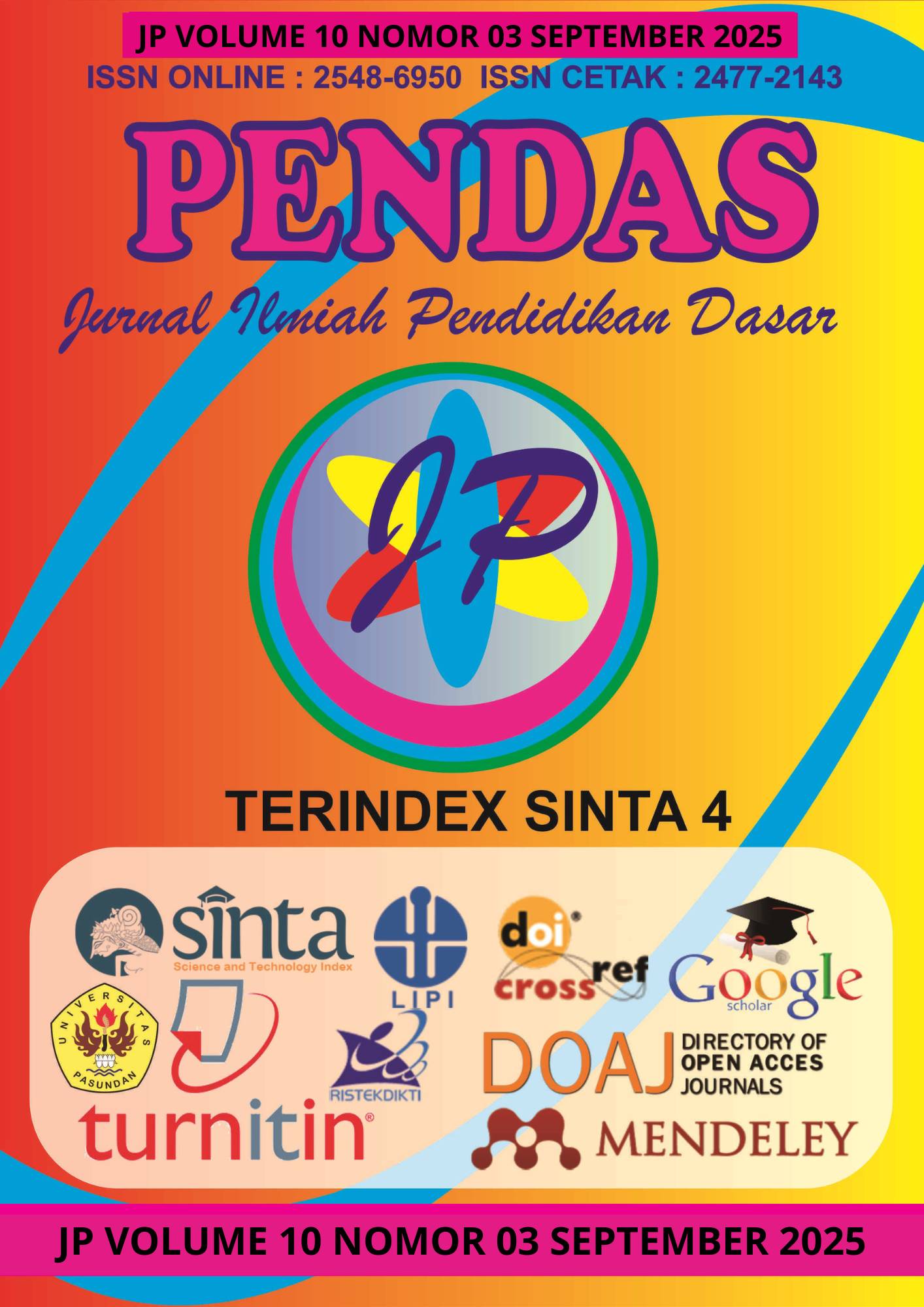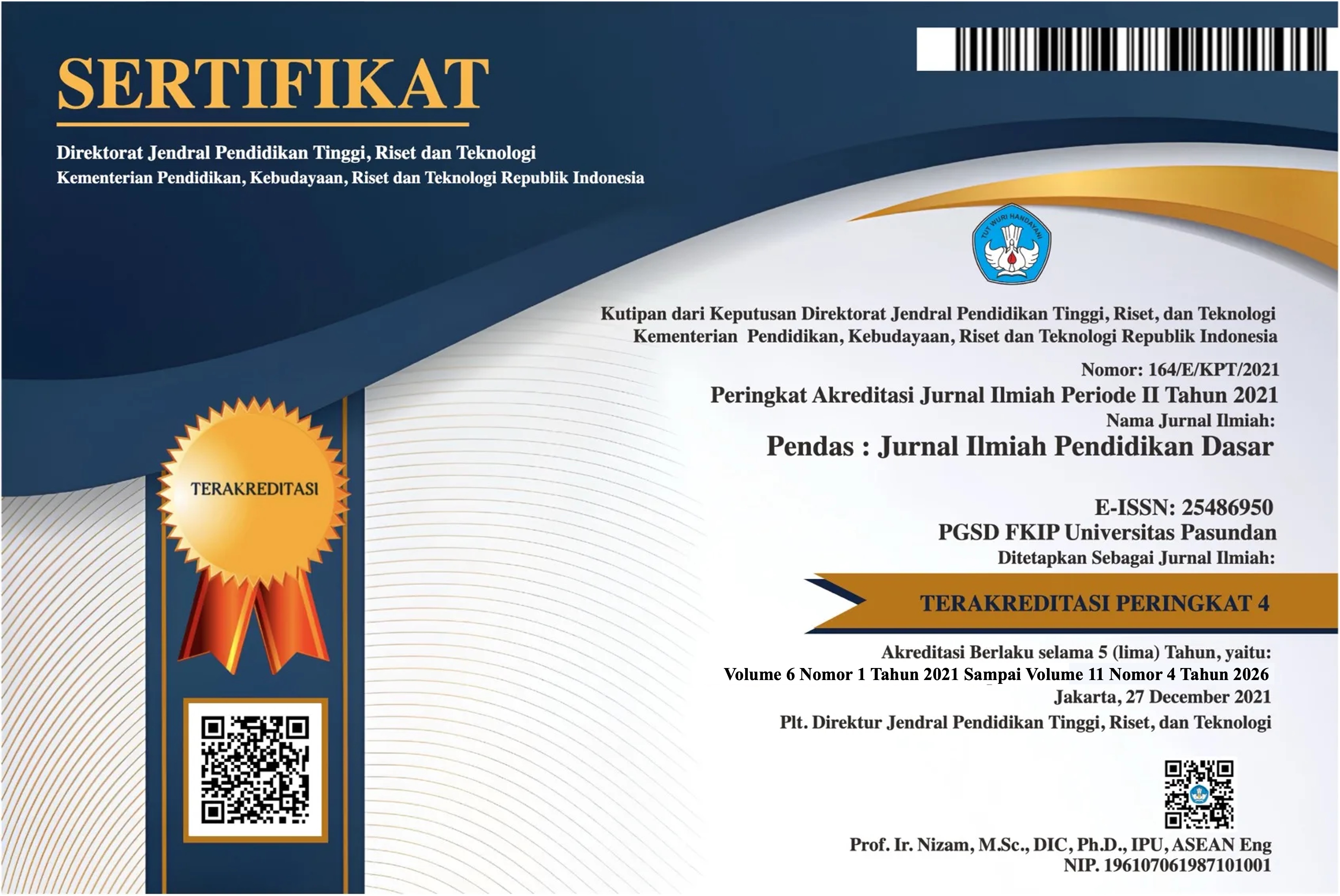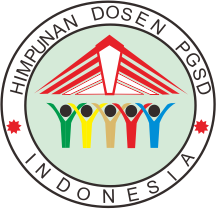Pengembangan Bahan Ajar “Eksplorasi Metamorfosis” berbasis Problem Based Learning untuk Meningkatkan Kemampuan Pemecahan Masalah Siswa Fase B Sekolah Dasar
DOI:
https://doi.org/10.23969/jp.v10i03.29316Keywords:
Elementary Science Teaching Materials, Problem Based Learning, Problem Solving, MetamorphosisAbstract
This study was motivated by the low problem-solving skills of third-grade elementary students in understanding animal metamorphosis. The absence of contextual teaching materials causes students to struggle in solving problems and participating actively in learning. This study aims to develop a teaching material called “Eksplorasi Metamorfosis” based on the Problem Based Learning (PBL) model to improve students' problem-solving abilities. The research method used was Design and Development (D&D), with the ADDIE model (analysis, design, development, implementation, and evaluation). Data collection techniques included questionnaires and tests involving 25 third-grade as subjects. Data were analyzed using qualitative and quantitative methods with a Likert scale. The developed teaching material follows the PBL syntax in a structured sequence, incorporates problem solving indicators, and aligns with specific learning objectives. The material offers strengths in its deeper exploration of metamorphosis content, a focused assessment approach that has not been widely developed, and its contextual presentation through an interactive design that encourages active student involvement. Expert validation results showed an overall score of 96.44%, categorized as very feasible. Cognitive test results showed an N-Gain score of 0.72, indicating high improvement in students' problem-solving abilities. Meanwhile, skill and affective assessments produced results ranging from good to excellent, reflecting students’ progress in both competence and positive attitudes during the learning process. It can be concluded that the “Eksplorasi Metamorfosis” teaching material is highly feasible to implement in learning and effective in improving problem-solving skills in the topic of metamorphosis for Phase B elementary students.
Downloads
References
Akker, J. van den, Bannan, B., Kelly, A. E., Nieveen, N., & Plomp, T. (2013). Educational Design Research (N. Nieveen & T. Plomp (ed.)). SLO, Enschede.
Andriani, M., Nawawi, & Herditiya. (2025). Analisis Kevalidan dan Keefektifan Modul Ajar Berbasis Problem Based Learning (PBL) terhadap Kemampuan Pemecahan Masalah pada Materi Sistem Pernapasan Kelas IX di SMA Negeri 1 Ngabang. IBEJ : Innovative Biology Education Journal, 01(02), 9–19.
Citradevi, C. P. (2023). Canva sebagai Media Pembelajaran pada Mata Pelajaran IPA: Seberapa Efektif? Sebuah Studi Literatur. Ideguru: Jurnal Karya Ilmiah Guru, 8(2), 270–275. https://doi.org/10.51169/ideguru.v8i2.525
Dewi, A. N., Juliyanto, E., & Rahayu, R. (2021). Pengaruh Pembelajaran IPA dengan Pendekatan Computational Thinking Berbantuan Scratch Terhadap Kemampuan Pemecahan Masalah. Indonesian Journal of Natural Science Education (IJNSE), 4(2), 92–97. https://doi.org/10.31002/nse.v4i2.2023
Dinda R, S., & Atmojo, S. (2024). Efektivitas Model Problem Based Learning (Pbl) Terhadap Kemampuan Pemecahan Masalah Dan Motivasi Siswa Pada Pembelajaran Ipa Di Kelas V Sd Negeri 1 Padokan. LENSA (Lentera Sains): Jurnal Pendidikan IPA, 14(1), 48–57. https://doi.org/10.24929/lensa.v14i1.399
Hastiwi, F., Khasanah, U., & Wahyuningsih, S. (2023). Peningkatan Keaktifan dan Hasil Belajar IPAS Menggunakan Model Problem Based Learning Kelas IV SD Muhammadiyah Kleco 2 Tahun Ajaran 2022/2023. Kalam Cendekia: Jurnal Ilmiah Kependidikan, 11(2), 251–262. https://doi.org/10.20961/jkc.v11i2.75334
Humaidi, Irhasyuarna, Y., & Hafizah, E. (2022). Analisis Validitas Terhadap Pengembangan Bahan Ajar IPA Berbasis Literasi Sains pada Materi Objek IPA dan Pengamatannya. Jurna Pahlawan, 18(01), 11–15.
Kusumandari, D., Dina, D. M., & Nuraminudin, M. (2024). Perancangan Media Pembelajaran Metamorfosis Kupu-Kupu Menggunakan Teknik Motion Graphic. Information System Journal, 7(01), 56–66. https://doi.org/10.24076/infosjournal.2024v7i01.1375
Lailiyah, N. N., & Widiyono, A. (2023). Pengembangan Media Diorama berbasis STEAM untuk Meningkatkan Keterampilan Berpikir Kritis Siswa di Sekolah Dasar. BASICA Journal of Arts and Science in Primary Education, 3(1), 95–108. https://doi.org/10.37680/basica.v3i1.3678
Marcela, R., Idris, M., & Aryaningrum, K. (2022). Pengembangan Media Permainan Ular Tangga dalam Pembelajaran IPS Siswa Kelas IV SD Negeri 138 Palembang. Jote: Journal On Teacher Education, 4(1), 54–61. https://doi.org/https://doi.org/10.31004/jote.v4i1.5680
Muyassaroh, I., Mukhlis, S., & Ramadhani, A. (2022). Model Project Based Learning melalui Pendekatan STEM untuk Meningkatkan Kemampuan Pemecahan Masalah Siswa SD. Jurnal Educatio FKIP UNMA, 8(4), 1607–1616. https://doi.org/10.31949/educatio.v8i4.4056
OECD. (2023). PISA 2022 Results The State of Learning and Equity in Educatio. In Perfiles Educativos (Vol. 1, Nomor 183). https://doi.org/10.22201/iisue.24486167e.2024.183.61714
Pebriani, N. P. I., Putrayasa, I. ., & Margunayasa, I. . (2022). Pengembangan E-Lkpd Berbasis Hots (Higher Order Thinking Skill) Dengan Pendekatan Saintifik Pada Pembelajaran Ipa Tema 8 Kelas V Sd. Jurnal Penelitian dan Evaluasi Pendidikan Indonesia, 12(1), 76–89. https://doi.org/10.23887/jpepi.v12i1.980
Polya, G. (1957). How to Solve It (second edi). Princeton University Press.
Prasetyo, R., & Asmara, R. (2024). Kohesi dan Koherensi Teks Bacaan dalam Buku Bahasa Indonesia SMP Kelas VII Kurikulum Merdeka. Mabasan: Masyarakat Bahasa & Sastra Nusantara, 18(2), 345–364.
Putri, I. S., & Kelana, J. B. (2022). Akker, J. van den, Bannan, B., Kelly, A. E., Nieveen, N., & Plomp, T. (2013). Educational Design Research (N. Nieveen & T. Plomp (ed.)). SLO, Enschede.
Andriani, M., Nawawi, & Herditiya. (2025). Analisis Kevalidan dan Keefektifan Modul Ajar Berbasis Problem Based Learning (PBL) terhadap Kemampuan Pemecahan Masalah pada Materi Sistem Pernapasan Kelas IX di SMA Negeri 1 Ngabang. IBEJ : Innovative Biology Education Journal, 01(02), 9–19.
Citradevi, C. P. (2023). Canva sebagai Media Pembelajaran pada Mata Pelajaran IPA: Seberapa Efektif? Sebuah Studi Literatur. Ideguru: Jurnal Karya Ilmiah Guru, 8(2), 270–275. https://doi.org/10.51169/ideguru.v8i2.525
Dewi, A. N., Juliyanto, E., & Rahayu, R. (2021). Pengaruh Pembelajaran IPA dengan Pendekatan Computational Thinking Berbantuan Scratch Terhadap Kemampuan Pemecahan Masalah. Indonesian Journal of Natural Science Education (IJNSE), 4(2), 92–97. https://doi.org/10.31002/nse.v4i2.2023
Dinda R, S., & Atmojo, S. (2024). Efektivitas Model Problem Based Learning (Pbl) Terhadap Kemampuan Pemecahan Masalah Dan Motivasi Siswa Pada Pembelajaran Ipa Di Kelas V Sd Negeri 1 Padokan. LENSA (Lentera Sains): Jurnal Pendidikan IPA, 14(1), 48–57. https://doi.org/10.24929/lensa.v14i1.399
Hastiwi, F., Khasanah, U., & Wahyuningsih, S. (2023). Peningkatan Keaktifan dan Hasil Belajar IPAS Menggunakan Model Problem Based Learning Kelas IV SD Muhammadiyah Kleco 2 Tahun Ajaran 2022/2023. Kalam Cendekia: Jurnal Ilmiah Kependidikan, 11(2), 251–262. https://doi.org/10.20961/jkc.v11i2.75334
Humaidi, Irhasyuarna, Y., & Hafizah, E. (2022). Analisis Validitas Terhadap Pengembangan Bahan Ajar IPA Berbasis Literasi Sains pada Materi Objek IPA dan Pengamatannya. Jurna Pahlawan, 18(01), 11–15.
Kusumandari, D., Dina, D. M., & Nuraminudin, M. (2024). Perancangan Media Pembelajaran Metamorfosis Kupu-Kupu Menggunakan Teknik Motion Graphic. Information System Journal, 7(01), 56–66. https://doi.org/10.24076/infosjournal.2024v7i01.1375
Lailiyah, N. N., & Widiyono, A. (2023). Pengembangan Media Diorama berbasis STEAM untuk Meningkatkan Keterampilan Berpikir Kritis Siswa di Sekolah Dasar. BASICA Journal of Arts and Science in Primary Education, 3(1), 95–108. https://doi.org/10.37680/basica.v3i1.3678
Marcela, R., Idris, M., & Aryaningrum, K. (2022). Pengembangan Media Permainan Ular Tangga dalam Pembelajaran IPS Siswa Kelas IV SD Negeri 138 Palembang. Jote: Journal On Teacher Education, 4(1), 54–61. https://doi.org/https://doi.org/10.31004/jote.v4i1.5680
Muyassaroh, I., Mukhlis, S., & Ramadhani, A. (2022). Model Project Based Learning melalui Pendekatan STEM untuk Meningkatkan Kemampuan Pemecahan Masalah Siswa SD. Jurnal Educatio FKIP UNMA, 8(4), 1607–1616. https://doi.org/10.31949/educatio.v8i4.4056
OECD. (2023). PISA 2022 Results The State of Learning and Equity in Educatio. In Perfiles Educativos (Vol. 1, Nomor 183). https://doi.org/10.22201/iisue.24486167e.2024.183.61714
Pebriani, N. P. I., Putrayasa, I. ., & Margunayasa, I. . (2022). Pengembangan E-Lkpd Berbasis Hots (Higher Order Thinking Skill) Dengan Pendekatan Saintifik Pada Pembelajaran Ipa Tema 8 Kelas V Sd. Jurnal Penelitian dan Evaluasi Pendidikan Indonesia, 12(1), 76–89. https://doi.org/10.23887/jpepi.v12i1.980
Polya, G. (1957). How to Solve It (second edi). Princeton University Press.
Prasetyo, R., & Asmara, R. (2024). Kohesi dan Koherensi Teks Bacaan dalam Buku Bahasa Indonesia SMP Kelas VII Kurikulum Merdeka. Mabasan: Masyarakat Bahasa & Sastra Nusantara, 18(2), 345–364.
Putri, I. S., & Kelana, J. B. (2022). Pengembangan Bahan Ajar Pada Materi Tata Surya Dengan Menggunakan Model Student Teams Achievement Division Berbantuan Aplikasi Solar System Scope Dan Book Creator Untuk Meningkatkan Pemahaman Konsep IPA Kelas VI Sekolah Dasar. Jurnal Profesi Pendidikan, 1(2), 67–81. https://doi.org/10.22460/jpp.v1i2.13024
Utami, N., & Atmojo, I. R. W. (2021). Analisis Kebutuhan Bahan Ajar Digital dalam Pembelajaran IPA di Sekolah Dasar. Jurnal Basicedu, 5(6), 6300–6306. https://doi.org/https://doi.org/10.31004/basicedu.v5i6.1716
Widiastuti, N. L. G. K. (2020). Pengembangan Bahan Ajar Ipa Berbasis Kontekstual Dengan Konsep Tri Hita Karana Untuk Meningkatkan Pemahaman Konsep Siswa. Jurnal Ilmiah Pendidikan dan Pembelajaran, 4(3), 479–490.
Downloads
Published
Issue
Section
License
Copyright (c) 2025 Pendas : Jurnal Ilmiah Pendidikan Dasar

This work is licensed under a Creative Commons Attribution 4.0 International License.



















